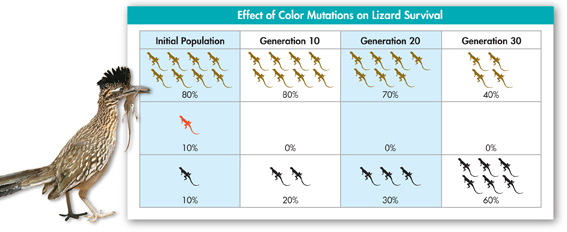Natural Selection on Single-Gene Traits Recall that evolution is any change over time in the allele frequency in a population. This process works somewhat differently for single-gene traits than for polygenic traits.  Natural selection on single-gene traits can lead to changes in allele frequencies and, thus, to changes in phenotype frequencies. For example, imagine that a population of lizards experiences mutations in one gene that determines body color. The normal color of the lizards is brown. The mutations produce red and black forms, as shown in Figure 17–6. What happens to the new alleles? If red lizards are more visible to predators, they might be less likely to survive and reproduce. Therefore, the allele for red coloring might not become common.
Natural selection on single-gene traits can lead to changes in allele frequencies and, thus, to changes in phenotype frequencies. For example, imagine that a population of lizards experiences mutations in one gene that determines body color. The normal color of the lizards is brown. The mutations produce red and black forms, as shown in Figure 17–6. What happens to the new alleles? If red lizards are more visible to predators, they might be less likely to survive and reproduce. Therefore, the allele for red coloring might not become common.
Black lizards, on the other hand, might absorb more sunlight and warm up faster on cold days. If high body temperature allows the lizards to move faster to feed and avoid predators, they might produce more offspring than brown forms produce. The allele for black color might increase in frequency. The black phenotype would then increase in frequency. If color change has no effect on fitness, the allele that produces it will not be under pressure from natural selection.
MYSTERY CLUE

Normally, our immune systems kill or disable disease-causing viruses. What might happen if one flu virus had a mutation that enabled it to escape the body's defenses?

FIGURE 17–6 Selection on a Single-Gene Trait Natural selection on a single-gene trait can lead to changes in allele frequencies and, thus, to evolution. Interpret Visuals What has happened to produce the population shown in Generation 30?
ddNatural Selection on Polygenic Traits When traits are controlled by more than one gene, the effects of natural selection are more complex. As you saw earlier, polygenic traits such as height often display a range of phenotypes that form a bell curve. The fitness of individuals may vary from one end of such a curve to the other. Where fitness varies, natural selection can act.  Natural selection on polygenic traits can affect the relative fitness of phenotypes and thereby produce one of three types of selection: directional selection, stabilizing selection, or disruptive selection. These types of selection are shown in Figure 17–7.
Natural selection on polygenic traits can affect the relative fitness of phenotypes and thereby produce one of three types of selection: directional selection, stabilizing selection, or disruptive selection. These types of selection are shown in Figure 17–7.
 In Your Notebook As you read the text on the following page, summarize each of the three types of selection.
In Your Notebook As you read the text on the following page, summarize each of the three types of selection.
Table of Contents
- Formulas and Equations
- Applying Formulas and Equations
- Mean, Median, and Mode
- Estimation
- Using Measurements in Calculations
- Effects of Measurement Errors
- Accuracy
- Precision
- Comparing Accuracy and Precision
- Significant Figures
- Calculating With Significant Figures
- Scientific Notation
- Calculating With Scientific Notation
- Dimensional Analysis
- Applying Dimensional Analysis




